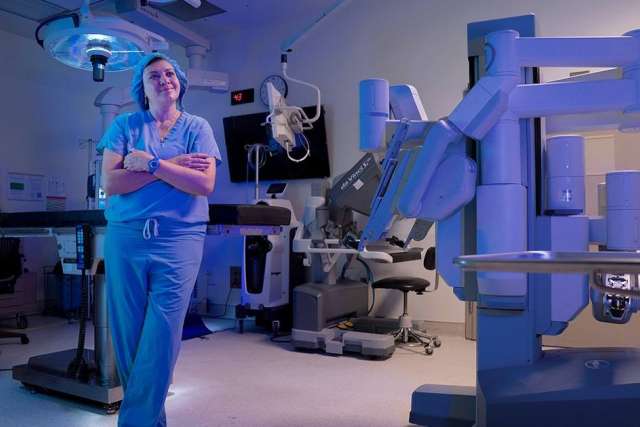The diagnoses and a death of some high-profile celebrities in recent years have shined a light on oropharyngeal cancer — sometimes generically referred to as throat cancer.
Oropharyngeal cancer is a disease in which malignant cancer cells form in the tissues of the oropharynx, which includes the back of the throat, the base of the tongue and the tonsils.
Between 70% and 90% of cases are caused by HPV-16, one of the subtypes of the human papillomavirus (HPV), a disease transmitted primarily through oral sex, says Dr. Maie St. John, MD, PhD, FACS, chair of the Department of Head and Neck Surgery and co-director of UCLA’s Head and Neck Cancer Program.
Estimates are that 90% of adults have been exposed to HPV-16 upon becoming sexually active, says Dr. St. John, who also is the Director of Cancer Research Career Enhancement at the UCLA Jonsson Comprehensive Cancer Center.
Oropharyngeal cancer, however, remains relatively rare, she says.
Each year, about 12,000 cases of HPV-associated cancers of the oropharynx are diagnosed in the U.S., and more than 80% of cases are in men, Dr. St. John says. According to statistics from the National Cancer Institute’s Surveillance, Epidemiology and End Results (SEER) data base registry, men have a lifetime risk of these cancers of 0.7% and women, 0.2%.
“So, oftentimes people find this pretty reassuring,” Dr. St. John adds.
The number of lifetime sexual partners has been found to be associated with a higher oral HPV prevalence, as has a history of smoking, Dr. St. John says.
Fortunately, the long-term prognosis for people with HPV-positive throat cancers is good. While the prevalence of throat cancers is steadily rising – there has a been a four- to fivefold increase in cases over the past decade – HPV-positive throat cancer patients have a disease-free survival rate of 85% to 90% over five years, Dr. St. John says.
“This is in contrast to head and neck cancers linked to smoking and drinking, where the five-year survival rate is 25 to 40%,” she adds.
Dr. St. John notes there are ongoing studies and strategies for using biomarkers to determine people at risk for oropharyngeal cancer, but no test has been validated to predict whether someone can develop it.
So, who should get screened? People who have a history of alcohol or tobacco use, a history of exposure to radiation therapy or symptoms including a neck mass, hoarseness, pain or difficulty when swallowing or chewing, and a change in voice, she says.
A vaccine developed to protect against high-risk HPV infection has been approved for use in people starting at age 9. However, Dr. St. John cautions, vaccinating adults does not appear to protect them from developing cancer and it does not treat adults already infected.
Treatment for oropharyngeal cancer can include surgery, radiation therapy, chemotherapy and immunotherapy. New technologies have vastly improved treatment, survival and side effects from the disease, Dr. St. John says. She calls the use of robotic-assisted surgery to treat HPV-positive cases “revolutionary.”
UCLA Health is the first medical system in Southern California to perform robotic surgery on patients using the latest-model Da Vinci (SP) single port robot.
“It can be done transorally (by mouth), and the patient can often go home within two to three days after surgery,” she says.
UCLA Health is developing a specific camera-imaging system to screen for those who might be at risk for developing HPV-positive cancers and has launched educational programs for high school students, undergrads and medical students to promote HPV vaccination and to educate them on the risks of HPV-related cancers.
Jennifer Karmarkar is the author of this article.



